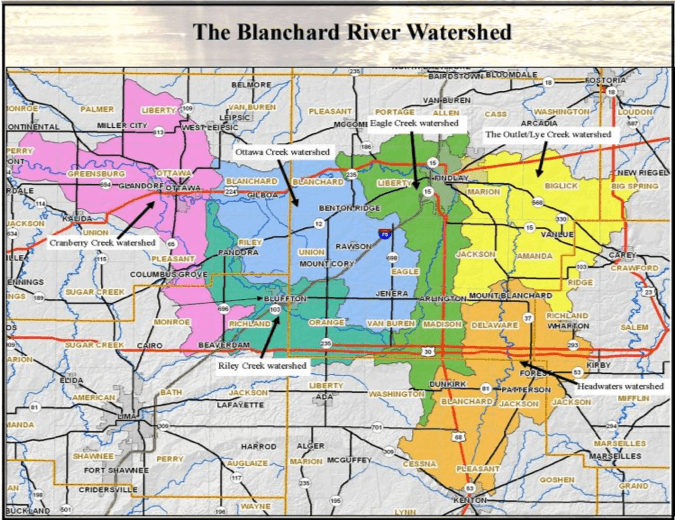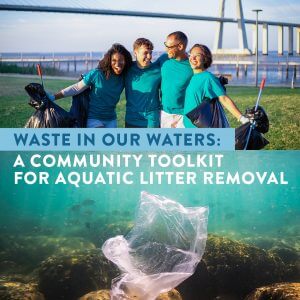How 90 High Schoolers Removed Over 1 Ton of Community Litter
Earlier this year, in collaboration with River Network and with support from Ball Corporation, Findlay, Ohio’s Blanchard River Watershed Partnership (BRWP) and the local United Way organized an Earth Week clean-up event opportunity for 90 National Honors Society (NHS) students to collaborate with their community, gain valuable leadership skills and foster a commitment to maintaining a healthy, clean environment free of litter.

Courtesy Blanchard River Watershed Partnership.
Findlay is a small town of about 40,000 people nestled almost halfway between the major metropolitan areas of Toledo and Columbus. Since 2006, the Blanchard River Water Partnership has led local efforts to address concerns affecting the integrity of the Blanchard River watershed, which serves as the drinking water source for Findlay’s residents and neighboring communities. For the Earth Week event, BRWP brought together the Findlay community, local Ball plant, and Findlay High School NHS students, all in the name of clean water and a litter-free community.
Lauren Sandhu, BRWP’s Director and an Adjunct Instructor of Biology at the University of Findlay, helped organize and orchestrate the clean-up, which focused on four litter heavy areas across Findlay. Over the week-long event, participants removed an astonishing 5,776 pieces of litter weighing 1.27 tons from Findlay’s parks, neighborhoods, and sidewalks.
How’d they make it happen? How can you replicate their success for your local waters? Below are five key practices that emerged from this event and offer a framework for individuals or organizations planning and implementing similar litter clean-ups in their communities.
Build Momentum with an Engaged Partner and Specific Audience
If you are thinking of planning a litter clean-up event, it’s helpful to have an ally or a volunteer network to tap into as a way of building critical momentum leading up to the event. In the case of the Findlay Earth Week event, several NHS students had reached out to the local United Way chapter with interest in focusing their service hours this year on an environmental-related initiative. Looking for a partner to lead the event, United Way contacted BRWP, given their existing relationship spearheading similar projects together in the past. With a group of 90 NHS volunteers already committed to participating, BRWP was eager to help plan the event.
Universities, grade schools, community-service-oriented local organizations, environmental nonprofits, or faith-based groups are all excellent potential partners for such clean-ups. You can start by using River Network’s Water Protectors Map to research local groups to potentially partner with. Further, your local city or town hall, or library, could be a great resource to contact in search of local organizations dedicated to clean-up efforts and education that may already be planning upcoming events that you could collaborate on.
Provide Comprehensive Education and Training
Often, the first steps to building community-wide investment in litter management and encouraging participation in clean-up events are outreach and education. To this end, a primary component of the Blanchard River Watershed Partnership’s work is providing year-round public education events in Findlay that teach the community about waste pollution in the watershed and how to take steps to prevent it. The team at BRWP frequently delivers presentations at community events, K-12 schools, and in other settings to inform audiences on the topic, along with steps they are taking to address the problem. Before the NHS students committed to the project, BRWP delivered a presentation to the group, including a thorough overview of trash hotspots around Findlay—where waste tends to end up in waterways—and the environmental, social, and economic problems that this trash causes. Additionally, students learned how trash can critically imperil aquatic ecosystems and aquatic life, can cause toxic materials to leech into water supplies, and how escaped fishing nets frequently kill estuarine and marine life. Detailing the economic costs of litter pollution, the students learned that cleaning up visible litter costs about $11.5 billion in US taxpayer dollars each year.
Once these students became aware of the extent of the issue in their community, and the country overall, they were incredibly motivated to engage on the clean-up. After receiving buy-in from the students, BRWP worked with United Way representatives and the NHS program’s lead teacher to organize a follow-up presentation before the event to cover safe clean-up practices, including:
- Using tools (rather than hands) to pick up litter
- Wearing work or nitrile gloves to prevent injuries
- Practicing safe social distancing, keeping six feet from other participants, given the ongoing pandemic
- Wearing appropriate personal protective equipment (PPE), including face coverings or shields
- Avoiding picking up dangerous materials, including syringes, needles, or other sharp objects, without adult or expert supervision
- Separating trash and recyclables properly
- An overview of materials that can and cannot be recycled
The volunteers received this information again the day of the event to reinforce their prior learning and make sure all details were precise. For more information about topics to cover in a pre-event training session, especially an event that will be socially distanced, you can review this video and guidance from River Network.
 Identify Strategic Event Locations and Facilitate Transportation
Identify Strategic Event Locations and Facilitate Transportation
Several weeks ahead of time, BRWP identified four locations across Findlay where volunteers would collect litter throughout the weeklong event. The selected locations were safe—away from major highways or a lack of cell phone signal in case of an emergency—so as to not present any danger to volunteers. To make these four locations more accessible, BRWP and the United Way arranged for volunteer transportation from a central location at a set time. A local transportation company, HATS Transportation, generously donated several shuttles to transport the high school students, many of whom did not yet have their driver’s license, on the morning of the event. If it is not possible to arrange transportation to multiple sites, consider keeping the event dedicated to one or two sites at most and concentrate efforts there, to reduce logistical planning and any confusion arising from volunteers trying to find event sites.
For more information on evaluating your neighborhood’s litter profile to help identify your event’s site locations, check out the “Assessing Litter in Your Community” section of River Network’s Waste in Our Waters Community Toolkit.
Secure In-Kind Donations for Goods and Services
Hosting a clean-up event requires many supplies, from safety gear to trash bags. These supplies can be costly, but with some thoughtful planning they can often be sourced through in-kind donations. Over the years, BRWP has developed relationships with a variety of local Findlay businesses, which they can now rely on to secure donations, helping to keep event costs low. For example, BRWP and the United Way received donations from a local Meijer grocery store, which provided the students with safety vests, litter grabbers, work gloves, nitrile gloves, hand sanitizer, first aid kits, and large trash bags. When one student suggested that they make T-shirts to commemorate the event and easily identify one another during the clean-up, a student leader contacted local Flag City Printing to get a quote for the cost of 90 shirts. Flag City was happy to provide the shirts free of charge after learning about the mission of the event. The United Way also secured a lunch donation from a neighborhood Jimmy John’s, which supplied enough sandwiches for all participants.
Contacting local businesses who are invested in the community, informing them about your volunteer-led effort, and demonstrating mutual benefit of their in-kind donations can be a compelling reason for them to provide food or supply other donations. For example, you could offer visibility to a T-shirt printing company by including their logo on the shirt, a mutually beneficial exchange of services. If you have a Facebook page or event webpage, consider including a list of sponsors or donors to demonstrate those businesses’ goodwill and commitment to the community.
In-kind donations can vary from event supplies to donated fees and rentals. Through a prior relationship, BRWP was able to arrange for local waste management service H & O Services to donate a dumpster at each of the four event sites, which significantly reduced event costs by eliminating dumpster rental fees. Additionally, the Hancock County Commissioners waived H & O’s landfill dumping fee, reinforcing the idea that promoting the service-oriented nature of your event is helpful. It is best practice to call your city government ahead of time and ask about options for scheduling a pickup for trash and recycling. If you expect to collect a lot of waste, considering renting a dumpster. Budget Dumpster also offers donations to qualifying events around the country with a request form on its website.
Identify and Implement Programs for Future Trash Reduction
While organizing clean-up events is an excellent way to limit the social, environmental, and economic costs of litter entering your community’s rivers and other waterways, the best approach to managing litter starts with identifying where it is coming from and what measures might stem its tide. For example, BRWP worked with the University of Findlay to implement a major campus-wide recycling program, placing recycling and trash bins at strategic points on campus that seemed to be primary sources of litter. Sandhu believes this program alone will drastically reduce litter originating from campus. BRWP is also currently working with the city to implement fishing line recycling at often-used fishing points along the Blanchard River. Since fishing lines pose a significant risk of entanglement to larger aquatic life, along with mammals, raptors, and eagles, implementing designated disposal points and providing posted signs about the dangers of loose fishing lines will surely reduce these harms in Findlay.
Further, like BRWP continues to do, providing public education in your community on the dangers of litter and the need to properly dispose of trash and recycling will likely have a more lasting impact on your community than one clean-up event alone. Organizing events targeted toward younger generations, such as the Findlay Earth Week clean-up, is another excellent way to foster lasting, intergenerational environmental stewardship. Sandhu marveled at how motivated the NHS students were following the event to continue to engage in this work. Many of the students even organized independent clean-up challenges on the litter pickup app Litterati in the weeks following the event.
This event really allowed both the Findlay community and the students to embrace Earth Week and see first-hand that their community and their own water sources are affected by litter. The students were greatly impacted by the type of litter they saw and the amount of litter they picked up, especially since the litter was filtering into our waterways. This event inspired many of the students to continue picking up litter in the weeks following the event and even start their own litter challenges after the event ended, which was incredible to see!”
-Lauren Sandhu, Blanchard River Watershed Partnership
To learn more about addressing litter in your community, and keeping it out of your local waters, explore Waste in our Waters: A Community Toolkit for Aquatic Litter Removal.
Want support planning your own clean-up? Contact us!






Also check out https://santaclaritacadumpsterrental.com/ they are awesome!